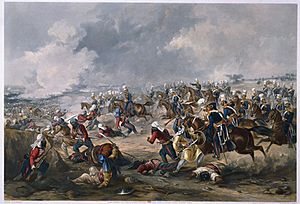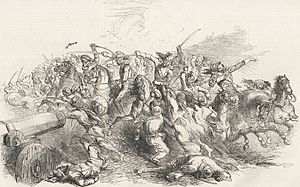Battle of Ramnagar facts for kids
Quick facts for kids Battle of Ramnagar |
|||||||
|---|---|---|---|---|---|---|---|
| Part of the Second Anglo-Sikh War | |||||||
 Charge of the 14th Light Dragoons at the Battle of Ramnagar, 22 November 1848 |
|||||||
|
|||||||
| Belligerents | |||||||
| Commanders and leaders | |||||||
| Sher Singh Attariwalla | Sir Hugh Gough | ||||||
| Strength | |||||||
| 23,000 men | 92,000 Infantry 31,800 Cavalry 384+ Guns |
||||||
| Casualties and losses | |||||||
| Unknown | 26 killed 59 wounded As per Patwant Singh and Jyoti M. Rai, “…92,000 men, 31,800 cavalry and over 384 guns were now reduced to a few thousand.” |
||||||
The Battle of Ramnagar was a fight that happened on November 22, 1848. It was part of the Second Anglo-Sikh War. The battle was between the British East India Company and the Sikh Empire. Sir Hugh Gough led the British forces. Sher Singh Attariwalla was the leader for the Sikhs. The Sikhs successfully stopped a surprise attack by the British.
Contents
Why the Battle Happened
After the First Anglo-Sikh War, the British had a lot of control in the Punjab. British officials were in charge. They used the Sikh Khalsa Army to keep order. Many Sikhs were unhappy with this setup. They also disliked the peace treaty terms. The Khalsa Army felt they had been betrayed, not truly defeated.
The second war began in April 1848. There was an uprising in the city of Multan. Its ruler, Dewan Mulraj, rebelled. The British Governor-General, Lord Dalhousie, sent a small army. This army was led by General Whish. He also ordered some Sikh troops to help Whish.
One large group of Sikh soldiers was led by Sardar (General) Sher Singh Attariwalla. Some British officials were worried. Sher Singh's father, Chattar Singh Attariwalla, was planning a rebellion.
On September 14, Sher Singh joined the rebellion. General Whish had to stop his attack on Multan. Sher Singh and Mulraj did not fully join forces. They met and agreed that Mulraj would give some money. Sher Singh then moved north to meet his father's army. This was not easy because other groups were fighting Chattar Singh.
Instead, Sher Singh moved a few miles north. He started making his positions stronger. He focused on the crossings of the Chenab River. His army grew larger. Many soldiers who had not yet rebelled joined him. Also, former soldiers who had been let go came to his side.
The Battle of Ramnagar
By November, the British had a large army ready. It was led by General Sir Hugh Gough. Gough had been criticized before. He often used direct attacks. These attacks led to many British soldiers getting hurt.
Early on November 22, Gough ordered a surprise attack. He sent cavalry (soldiers on horseback) and horse artillery. A small group of foot soldiers went with them. Their goal was to capture the Chenab River crossing near Ramnagar.
The Sikhs were in strong positions. They were on both sides of the river. They also held an island in the middle. The river was narrow, but its wide bed was tricky. It had soft sand. Horses and cannons could get stuck easily.
At dawn, the British arrived. British cavalry pushed some Sikhs back across the river. Then, hidden Sikh cannons started firing. The British cavalry struggled in the soft sand. Gough's cannons were outmatched. They had to retreat. They left behind one cannon that was stuck. The British commander, Sir Colin Campbell, wanted to get the cannon back. But Gough told him not to.
Sher Singh sent 3,000 horsemen across the river. They wanted to take advantage of the British trouble. Gough ordered his main cavalry to attack them. This included the 14th Light Dragoons. They pushed back the Sikh horsemen. But as they chased them, they faced heavy cannon fire. The Sikh cavalry also turned around and attacked. They caused many injuries to the British.
Colonel William Havelock led another charge. He was the commander of the 14th Light Dragoons. He and his leading soldiers were surrounded. They were killed. After a third attack failed, Brigadier Charles Robert Cureton arrived. He was the cavalry division commander. He ordered a retreat. Then, he himself was killed by gunfire.
What Happened After the Battle
The British reported 26 soldiers killed or missing. Another 59 were wounded. Brigadier General Cureton was among those killed.
Sher Singh had used the land and his preparations well. The Sikhs were pushed back from the east bank of the river. But their main positions were still strong. They had clearly stopped the British attack. This battle greatly boosted the spirits of Sher Singh's army.
On the British side, some problems were clear. They had not gathered enough information about the Sikh positions. General Gough and Colonel Havelock had ordered reckless attacks. Brigadier Cureton was known as a steady and skilled officer. He should have been in charge from the start.
Images for kids




